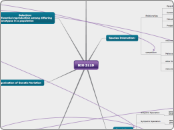by Stephanie Zalles 12 years ago
274
BIO 311D
Genetic variation is crucial for the survival and evolution of species, and it arises from several key processes. Mutations, though mostly harmful, are a primary source of new alleles.

by Stephanie Zalles 12 years ago
274

More like this
realized niche and fundamental niche are about the same size
are only able to live in very specific environments such as a canopy in a rainforest
have larger fundamental niches than realized niche
humans most closely related to chimpanzees with only 1.4% difference in genomic DNA
greates source of genetic variation
make new alleles
95% harmfull 4% neutral 1% beneficial
The introduction of a closely related species into the endagered population to introduce more genetic variability in order to enhance chances of survival by reducing inbreeding depression
adverse weather conditions speed up evolution
Automatic abortion of monosomes, trisomes because fetus develops slower
Components: Males compete, Females choose
selection is doe based on pheotype
ex: english moths that the birds were eating base on the ones that they could see, either white moths or peppered moths
as population increases birth rate decreases
contraception has decreased the total births in recent years
amount of education of women also affects this
as population density increases the mortality rate increases
more densily populated ares are more prone to enconter disease and to cause it to spread
EX: finches on Gallapagos Island with different sized beaks
development of phenotypic similarities between distantly related taxa over time
accumulation of phenotypic differences between two lineages originating from a common ancestor over time
similar changes in the phenotype between two geographically isolated taxa (species, genera, etc.)
when organism focus on a speciic resource to reduce competition
the male that best adapted will most likely be able to reproduce more than a male that is not very strong
Realized niche
the resources and habitats that an organism actually takes up
fundamental niche
the resources and habitats that an organism can use or take up
one organism depends on the other organism as a food source
both of the organisms benefit from the relationship
when one organisms benefits and the other one is not harmed
when one organism benefits and the other one is harmed